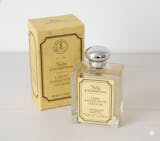Kamisori Straight Razor: Difference From A Traditional Straight Razor

The kamisori straight razor, also known as the Japanese straight razor, offers a distinctive shaving experience that departs from the conventional wet shaving practices of the West. At least in the case of a traditional Western wet shave, straight razors are the model for conventional single-edge razors. But there is an oriental counterpart to the traditional straight edge you are accustomed to.
Find out how a kamisori straight razor differs from a traditional straight edge and if it is worth trying.
- History: The Making Of The Japanese Straight Razors
- Kamisori Vs. Straight Razor: Which One To Use
- Alternative: The Next Best Thing To A Kamisori
- Where To Get A Kamisori Straight Razor
History: The Making Of The Japanese Straight Razors

The first Kamisori was used by monks and samurais for sacred rituals originating from the reign of Emperor Kinmei. Photo courtesy of History of Japan.
Singapore houses 213,000 of the top 1% of global wealth holders, living in opulence and luxury. This wealth has us thinking that a Crazy Rich Asian invented the kamisori straight razor in feudal Japan centuries ago. After all, straight razors were once a symbol of luxury and sophistication, only accessible to the elite in the West.
Razor in Japanese
The term "Kamisori" translates to "razor" in Japanese.1 While in Japan, any razor is referred to as kamisori, in Western contexts, it specifically represents the Japanese version of a straight razor. This distinction highlights the cultural influence and craftsmanship of the Kamisori razor, making it a unique and sought-after tool in traditional shaving practices.
Who Came Up with the Kamisori?
The term "Kamisori" holds deep cultural significance in the country of Japan. Originating during the reign of Emperor Kinmei in 538,2 it was initially referred to as a custom razor with a distinctive malleable and flat design used in Buddhist practices of shaving hair. Over time, the Japanese straight razor became popular among samurai warriors, who used the blades for shaving their heads and faces.3 By the Edo period, single-edge razors, incorporating Japanese sword-making techniques, became widely used as grooming tools.
Beyond the samurai class, using Kamisori razors spread in Japanese society. Boys would use it on the crown of their heads, and girls would use Kamisori razors to shape their eyebrows and remove fine hair from their skin. Eventually, folding Western-style razors introduced through contact with Portuguese civilization influenced the design of Kamisori razors.
Blade Types and Design
 The Kamisori has a thin and long blade without a folding handle. Photo courtesy of Wiki Commons.
The Kamisori has a thin and long blade without a folding handle. Photo courtesy of Wiki Commons.
The Kamisori, a distinctive type of straight razor, lacks a folding handle and resembles a flattened, sharpened spoon.4 It features a thin, long part instead of scales and boasts a shorter 2.5-inch blade. These razors have a unique blade shape, ground unevenly on both sides, originating from a triangular steel piece shaped into a "T," which requires less steel removal and reduces the time needed for honing.
Kamisori blades are crafted with separate versions for right-handed and left-handed individuals due to the specific grinding process involved. Unlike Western blades, Japanese razor blades are forged unequally, resulting in distinct characteristics on each side: the Ura and Omote sides.
Here are the differences between the Ura and Omote sides of a Kamisori:
- The Ura side features a significant hollow, while the Omote side is slightly ground out. This unique design ensures optimal performance and comfort based on the user's dominant hand.
- The Ura portion, made of steel, is honed to maintain a sharp edge, while the Omote portion, consisting of iron, is intentionally left largely inground.
- The hollow grind on the Ura side improves control and precision. The Omote side is stable and strong, making it ideal for heavier cutting tasks.
Traditionally, Japanese blades are constructed using a combination of soft iron and hard steel. The steel forms the sharp cutting edge, while the iron provides a sturdy base. The relatively soft iron (Omote) requires a thicker profile to support honing. This intricate balance of materials and grinding techniques contributes to the exceptional performance and versatility of Kamisori blades.
On that note, left-handed wet shavers must shave with a Kamisori with an Ura that favors your left hand. These days, however, shaving connoisseurs5 say that with the proper honing, one can shave with a Kamisori on both sides. It’s all a matter of preference.
Kamisori Vs. Straight Razor: Which One To Use
Physical differences aside, nothing is better or worse between a Kamisori razor and a straight razor. It’s just two razors that use different techniques that can give a fantastic result if done correctly. That being said, there are three qualities that you should look out for to help you decide which one will suit you.
• The Grind
Because a Kamisori is not ground in the same way on both sides, each side of the blade can be used to shave at a different angle. This gives you more ways to move the blade with ease than with a straight razor. This is very important, especially when you have a beard to maintain. If your facial hair has thick and thin areas, use one Kamisori side to cut through thick hair and flip it to style the thinner hair spots.
• The Grip
If you have problems holding on to a straight razor’s folding handle, then Kamisori’s straight handle will suit you. Because it’s not a folding handle, you don’t need to worry about slipping your grip. Kamisori handles are traditionally wrapped in natural twine and covered with rubber to ensure you can grip it the best way you know how.
• The Blade Length
Kamisori blades are usually no more than two inches in length. This makes it ideal for detailing your beard. It is small enough to easily maneuver it to trim your beard without accidentally cutting sideburns or mustaches. If you have thick and coarser hair, your best bet would be a heavy-bladed western single-edge razor. Because it's heavier and less flexible than a Kamisori, you can cut the hair easily, giving you a smoother shave.
Both kamisori and straight razors offer a fast and efficient shave in skilled hands. They are also both for shaving on sensitive skin to lessen shaving irritations. However, the delicateness of a kamisori is best for experienced wet shavers. Meanwhile, a straight razor can greatly assist beginners as the blade's width and size is more forgiving. But if you are keen to buy or purchase a Japanese vintage razor, you can look for a manufacturer to create a custom razor.
Alternative: The Next Best Thing To A Kamisori
 The Solomon Straight Razor's Japanese steel blade bears the same quality of today's samurai and kamisori blades.
The Solomon Straight Razor's Japanese steel blade bears the same quality of today's samurai and kamisori blades.
The Kamisori is a whole new level of shaving experience beyond its design. A Kamisori straight razor comes at a high price because of the high-quality steel and art that goes into its manufacture. If we compare their prices from high to low, the ultra-rare Tamahagane steel is the most expensive, which requires master-level artisanal skill. It’s the technique used to make legendary samurai swords in ancient times.
Because it’s a small blade, one might need more time and effort to learn how to use and maintain it properly. The honing, in particular, can be quite tricky to master because of the Kamisori’s unique grind. One might go through quite a lengthy period of slow, careful shaving until one becomes confident using the Kamisori.
A straight razor, meanwhile, will offer the same results at a slightly less expensive cost and shorter learning curve. They also have the potential to become heirloom pieces that increase in value each year. Also, most American men shave because they want to be clean-shaven and not because they want to maintain and style their beards. If you want a no-frills accessory to get the job done, then a straight razor will do the work nicely.
Where To Get A Kamisori Straight Razor
Naked Armor offers premium grooming tools, including a 6-piece set of Vintage Kamisori Straight Razors collection, featuring handcrafted Inoue Tōsuke and Tera Masa razors, celebrating artistry and precision in traditional Japanese shaving techniques.
You can also opt for a Western-style straight razor made from Japanese stainless steel. Naked Armor’s line of straight razors is artisanal-made from Japanese high-grade steel. It may not be Tamahagane grade steel, but it also comes from the ancient samurai tradition of blade making. This is why Naked Armor’s razor blades are light but keenly sharp. We use Japanese knife steel with a hardness of 61-65 HRC—the perfect mixture of strength and precision!
Get your one of a kind kamisori and click Add to Cart to order now!
More Naked Armor Reads:
Best Steel For Straight Razors: Carbon Vs. Stainless Blades
Why Are Razor Blades So Expensive?
Blade Sharpening: How To Hone A Straight Razor
References:
- English to Japanese Translation of Razor. Japanese Dictionary. japanesedictionary.org/translate-english/razor
- History Of Japanese Camisoli. Kamisori Club. https://www.kamisoriclub.co.jp/en/blogs/museum/japan-history. October 28, 2020
- History of Orihi type kamisori. History Razors. https://historyrazors.wordpress.com/2016/05/28/history-of-orihi-type-kamisori/. May 28, 2016
- JIMR. A Kamisori Primer. Sharpologist. https://sharpologist.com/a-kamisori-primer/. October 10, 2011
- J. Borrelli. Let’s Talk Kamisori. Shave Straight And Safe. https://shavestraightandsafe.com/2016/02/06/lets-talk-kamisori/. February 6, 2016




























Leave a comment